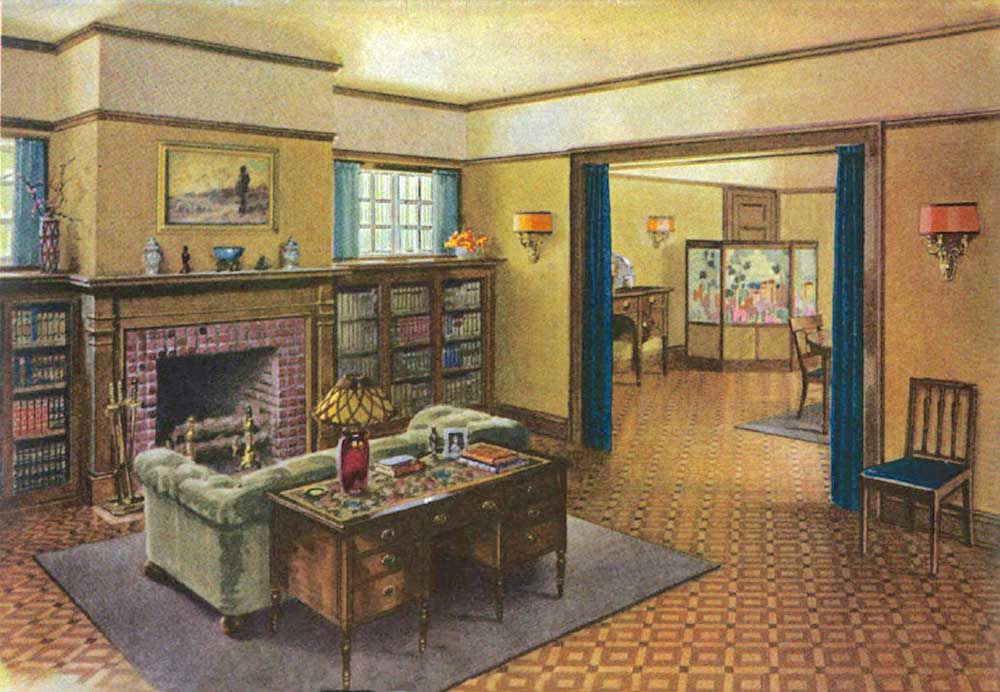Small Home Gazette, Summer 2017
Linoleum Discovered
One of my few regrets in life is not exposing sooner what I believe was our 1924 home’s original linoleum. Even with nail holes every 8 inches, the artful pattern was more attractive than the perma-dirt* vinyl tile squares we’d been living with for over a decade.
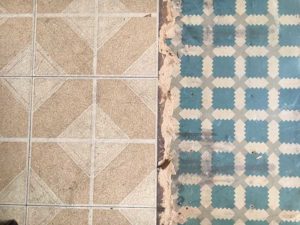
Pulling up our kitchen’s vinyl tile (left) revealed what I believe is the original linoleum (right).
To prevent me from backing out of a kitchen remodel a second time, I pulled up the vinyl tiles one section of floor at a time, using a hairdryer as a heat gun to soften the vinyl and adhesive. First, this revealed a sticky hardboard underlayment that I covered with old bed sheets so that we could walk on it. A month later when the sheets needed vacuuming, I picked, scab-like, at the ridged underlayment and tore away a layer of black construction paper backing to discover beautiful old linoleum.
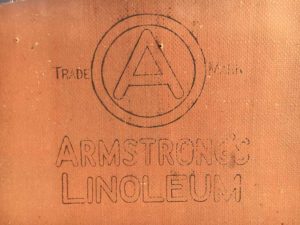 This gorgeous sheet had teal, jagged-edge squares with soft grey Xs connecting their corners. Bold, yes, and so very cool. Based on vintage linoleum patterns I found online, I would have sworn that we had Blabon art linoleum (see Resources). But once we removed our non-original lower cabinets, I found a section of the flooring clearly stamped “Armstrong’s Linoleum” on the back.
This gorgeous sheet had teal, jagged-edge squares with soft grey Xs connecting their corners. Bold, yes, and so very cool. Based on vintage linoleum patterns I found online, I would have sworn that we had Blabon art linoleum (see Resources). But once we removed our non-original lower cabinets, I found a section of the flooring clearly stamped “Armstrong’s Linoleum” on the back.
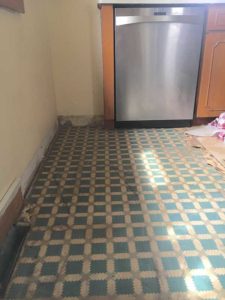 Linoleum has become a generic term for sheet flooring including vinyl, much like all flavored gelatin is called Jello. However, true linoleum is made from natural materials like linseed oil, tree resin, wood and cork flours (dust), limestone, and pigments applied on a jute burlap backing.
Linoleum has become a generic term for sheet flooring including vinyl, much like all flavored gelatin is called Jello. However, true linoleum is made from natural materials like linseed oil, tree resin, wood and cork flours (dust), limestone, and pigments applied on a jute burlap backing.
Linoleum is a Latin mash-up of the words linum (flax) and oleum (oil). Its manufacturing process was first patented in 1860.
Armstrong, originally in the cork stopper business, used cork waste in new product lines like cork boards and sold cork dust to linoleum manufacturers. Fears that the prohibition movement would hurt the cork stopper business, Armstrong started its own linoleum product line in 1908 and dominated the American market by the end of the 1920s.
Linoleum suited the hygiene-mindset of the industrial era. It is easy to clean, naturally antimicrobial, antistatic, and hypoallergenic. The product moved from use in industrial settings to installation in home kitchens and bathrooms. According to advertisements of the day, linoleum was suitable “for every floor in the house.” Linoleum was “flattering…even to the finest of rugs.” Heck, linoleum was even sold as rugs, touted for use in living rooms, dining rooms, and porches.
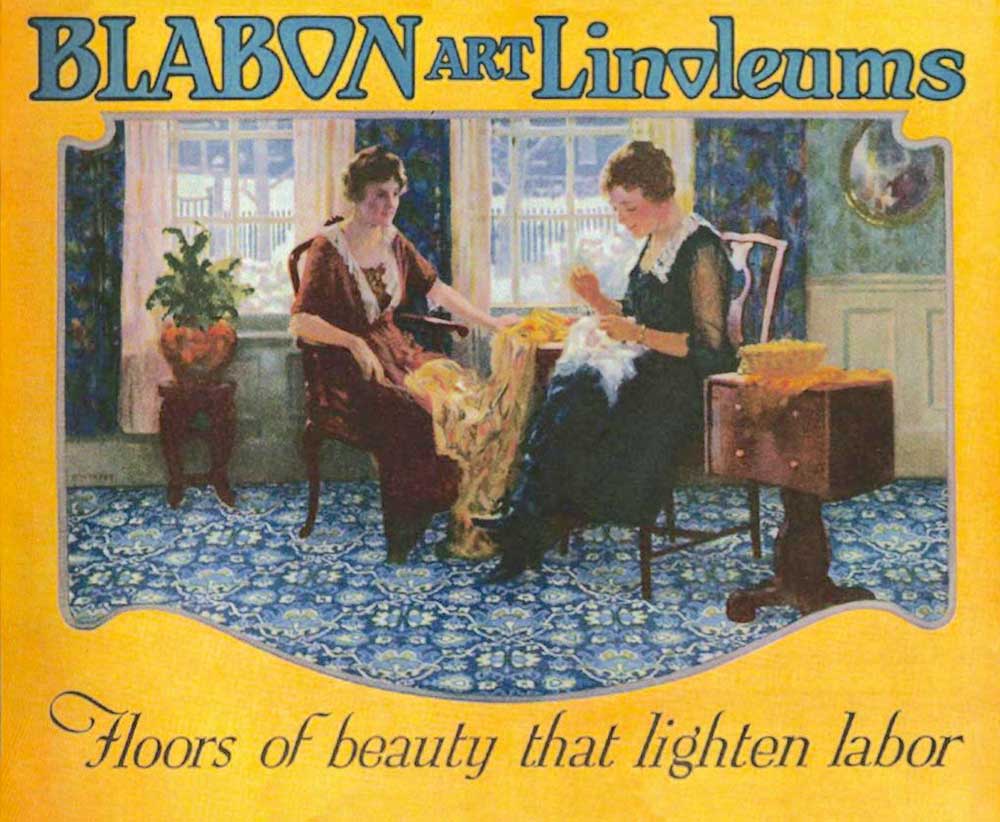
Blabon had an extensive selection of linoleum patterns, including one that was a near-match for our kitchen’s. See link in Resources section below for a full-color reproduction of their catalog.
A handful of true linoleum brands are still available today: Farbo Marmoleum, Nova Linoleum, and, yep, Armstrong is still going strong. Although today’s styles lack the intricacy and boldness of early designs, you can create more interesting looks by piecing together squares, cutting in designs or even have tailor-made laser engraving, for a price.
You might have a hard time finding a vintage linoleum rug that’s still in usable condition. But if you feel craftsy and ambitious, you can make your own linoleum rug. Also, vinyl floorcloth can simulate the look and practicality of vintage floor coverings.
Oh, and another regret. Since I removed all layers of flooring from our kitchen, future owners of our home will not have the same joy-filled flooring discovery I had.
* Dirty grooves even after vigorous cleaning on hands and knees with a scrub brush.
Resources
Galaxie Floor Stores, Bloomington
Local source for linoleum and professional installation.
galaxiefloorstores.com
Spicher and Company
Inspired by old floor cloths and vintage linoleum, these vinyl floorcloths offer warm colors and beautiful patterns.
tinyurl.com/j4zag9v
Linoleum , a book by Jane Powell.
Quirky, photo-filled book covering the history of linoleum.
tinyurl.com/yaz5uah5
Web Articles
“All About Linoleum Flooring”
This Old House
tinyurl.com/y7v4ph74
Blabon Art Linoleums, Styles for 1921
See page 34, pattern No. 1424 C, for linoleum similar to what the author discovered in her kitchen.
tinyurl.com/ybvj5cmr
“History of Linoleum Rugs”
Jane Powell
tinyurl.com/yaxeshus
“Linoleum”
Vintage color images of rooms with linoleum.
tinyurl.com/ya786jzr
“Understanding the Art, Artifice, and Unlikely Appeal of Linoleum Rugs”
tinyurl.com/y8vtsn7y









